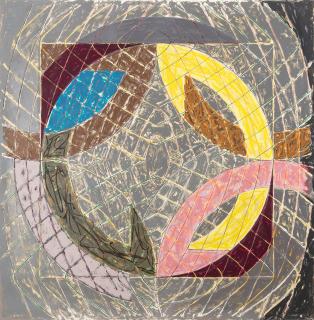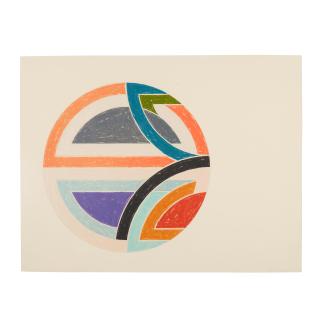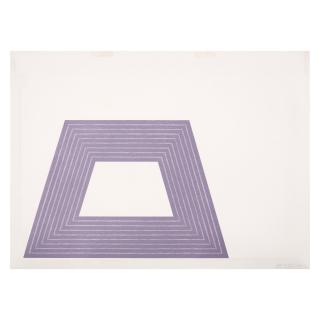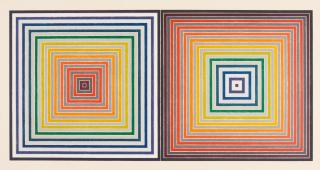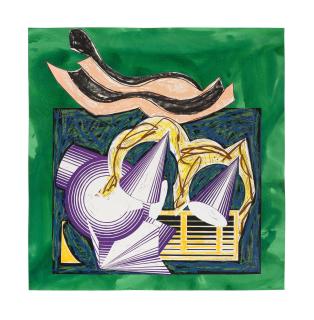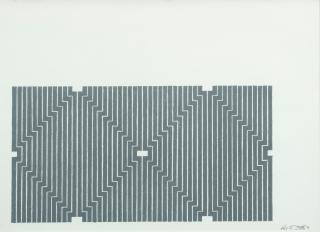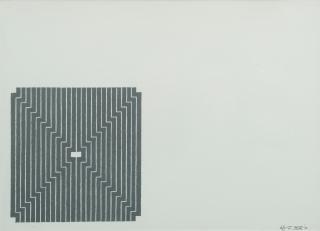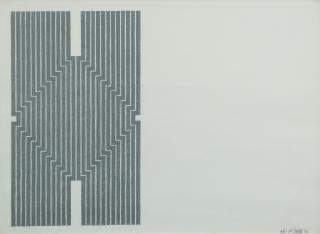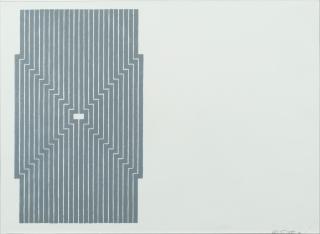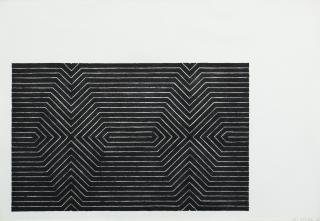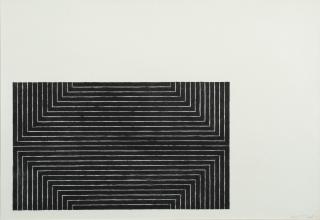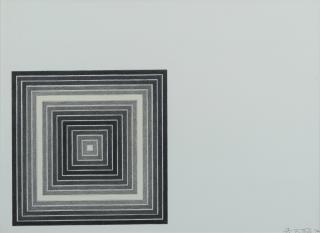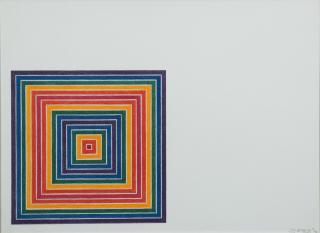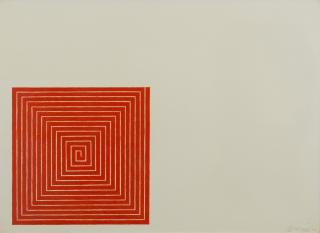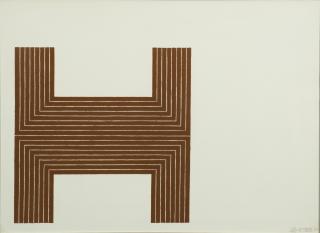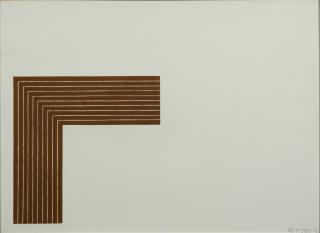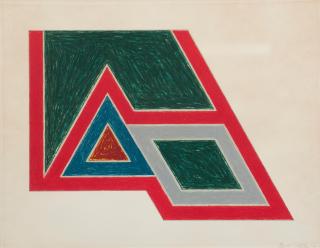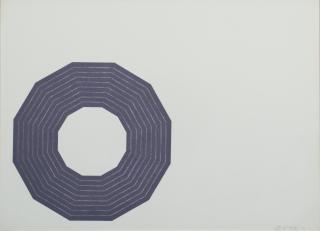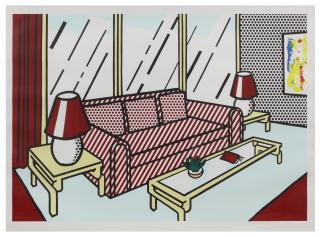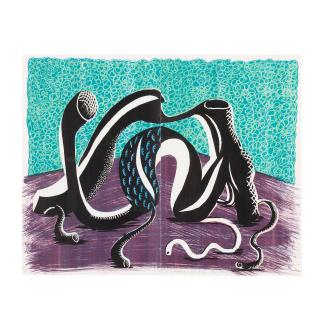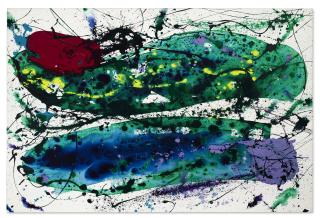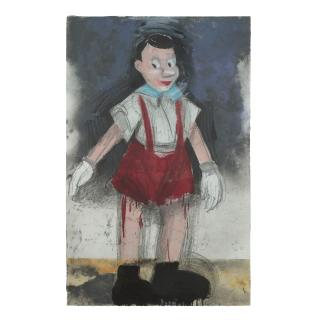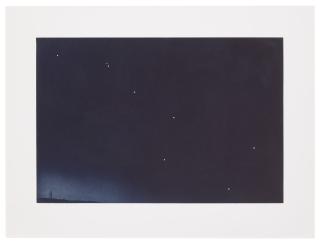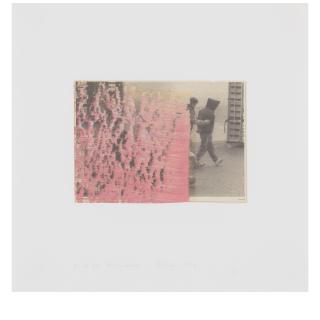Frank Stella born 1936
The artist Frank Stella
- US artist of Analytical Painting, Hard Edge and Colour Field painting.
- The Black Paintings, first exhibited in 1959, are now iconic works of minimalism.
- Designed large parts of The Princess of Wales Theatre in Toronto.
Frank Stella, born 12 May 1936 in Malden, Massachusetts, is an American artist associated with Analytical Painting, Hard Edge and Colour Field painting. Stella studied history at Princeton University in New Jersey until 1958 and then moved to New York. While still studying history, he devoted himself to painting by taking courses with abstract expressionists such as William C. Seitz and Stephen Greene. These courses and visits to various art galleries of New York influenced his early work.
At first, Stella also oriented himself towards the Abstract Expressionism of Jackson Pollock and Franz Kline. Soon, he found a new source of inspiration in the works of artists such as Barnett Newman, Mark Rothko and, in particular, the Target Paintings of Jasper Johns, which he encountered at Johns' first solo exhibition in 1958. From this point on, he began to design his works increasingly geometrically and to reduce colours.
In 1959, his Black Paintings, a series of monochrome paintings with symmetrically arranged black stripes on white ground, were shown for the first time as part of the exhibition 16 Americans at the Museum of Modern Art in New York. The paintings caused a sensation, among other things because some of the works bore titles associated with National Socialism, while others referred to great misfortunes, slum-like residential areas and New York nightclubs.
The Black Paintings have an ambivalent effect on many viewers, as they are simultaneously perceived as fascinating, highly aesthetic but also oppressive - and thus in a way reflect and decipher the reference points indicated by the titles. His first solo show followed in 1960 at the Leo Castelli Gallery in New York. His paintings were now colourful and also included dynamic elements, ascribing to them "space-staggering qualities"; the inclusion of space generally played an ever-increasing role.
Stella himself once commented on his geometric art with the words: "What you see is what you see". With this statement, he wanted to make it clear that viewers had direct access to his art. In 1970, he was allowed to look at his works in a retrospective at a very young age - for this was dedicated to him by the Museum of Modern Art in New York.
Stella's portfolio does not only include paintings - large-scale sculptures and the interior design of various buildings were also part of his later work. Between 1992 and 1993 he was allowed to design large parts of the interiors of the Princess of Wales Theatre in Toronto as well as the foyer in the new building of the Axel Springer House in Hamburg in 1996.
Der Künstler Frank Stella
- US-amerikanischer Künstler der Analytischen Malerei, des Hard Edge und der Farbfeldmalerei.
- Die 1959 erstmals ausgestellten Black Paintings sind heute ikonische Werke des Minimalismus.
- Gestaltete das Foyer des Axel-Springer-Hauses in Hamburg.
Frank Stella, geb. am 12.05.1936 in Malden, Massachusetts, ist ein US-amerikanischer Künstler, der der Analytischen Malerei, der Hard Edge sowie der Farbfeldmalerei zugeordnet wird. Stella studierte bis 1958 an der Princeton University in New Jersey Geschichte und zog anschließend nach New York. Bereits während seines Geschichtsstudiums widmete er sich der Malerei, indem er Kurse bei abstrakten Expressionisten wie William C. Seitz und Stephen Greene absolvierte.
Diese Kurse sowie Besuche in verschiedenen New Yorker Kunstgalerien nahmen Einfluss auf sein frühes Schaffen. So orientierte Stella sich vorerst auch am abstrakten Expressionismus Jackson Pollocks und Franz Klines. Schon bald fand er aber vor allem in den Werken von Barnett Newman, Mark Rothko und insbesondere in den Target Paintings von Jasper Johns, mit denen er auf dessen erster Einzelausstellung 1958 in Berührung kam, eine neue Inspirationsquelle.
Ab diesem Zeitpunkt fing er an, die Formen in seinen Arbeiten zunehmend geometrischer zu gestalten und Farben zu reduzieren. 1959 waren seine Black Paintings, eine Serie von monochromen Gemälden mit symmetrisch angeordneten schwarzen Streifen auf weißem Grund, erstmals im Rahmen der Ausstellung 16 Americans im Museum of Modern Art in New York zu sehen. Die Gemälde sorgten für Aufsehen, unter anderem weil einzelne der Arbeiten Titel trugen, die mit dem Nationalsozialismus assoziiert wurden, während andere auf große Unglücke, slumartige Wohngebiete und New Yorker Nachtclubs verwiesen.
Die Black Paintings haben auf viele Betrachter eine ambivalente Wirkung, da sie gleichzeitig als faszinierend, hochgradig ästhetisch aber auch beklemmend wahrgenommen werden – und somit in gewisser Weise die durch die Titel aufgezeigten Referenzpunkte widerspiegeln und dechiffrieren. 1960 folgte seine erste Einzelschau in der Leo Castelli Gallery in New York. Seine Bilder waren nun farbig und beinhalteten auch dynamische Elemente, wodurch ihnen »raumstaffelnde Eigenschaften« zugeschrieben werden;
der Einbezug des Raumes spielte generell eine immer größer werdende Rolle. Stella selbst äußerte sich zu seiner geometrischen Kunst einmal mit den Worten: »What you see is what you see.« Mit dieser Aussage wollte er verdeutlichen, dass den Betrachtern ein direkter Zugang zu seiner Kunst möglich sei. 1970 durfte er bereits in sehr jungen Jahren in der Retrospektive auf seine Werke blicken – denn diese widmete ihm das Museum of Modern Art in New York.
In sein Portfolio gehören nicht nur Gemälde – auch großformatige Skulpturen und die innenarchitektonische Gestaltung verschiedener Gebäude kamen später hinzu. 1992 bis 1993 durfte er etwa große Teile der Innenräume des Princess of Wales Theatres in Toronto sowie 1996 das Foyer im Neubau des Axel-Springer-Hauses in Hamburg gestalten.
Frank Stella in a nutshell
The artist has lived in New York since 1958, the time after his studies at Princeton University in New Jersey. In the 1970s he moved to NoHo, a Manhattan neighborhood. Currently, Stella lives in the neighboring Greenwich Village, but spends much of his time in his studio near New Windsor, a small town north of New York.
Stella's minimalistic approach was best exemplified by his series of paintings known as the Black Paintings, created in the late 1950s. These monochromatic, austere canvases feature precisely delineated black stripes and geometric patterns that evoke a sense of stark simplicity. By reducing his visual vocabulary to its most basic elements, Stella's art becomes a meditative exploration of form and structure, prompting viewers to contemplate the very nature of artistic representation.
Abstraction has been a hallmark of Frank Stella's artistic journey. His exploration of this realm has not only challenged viewers to engage with their own interpretations but has also inspired a reevaluation of the relationship between the artist, the artwork, and its audience. Stella's Irregular Polygons series exemplifies his commitment to abstraction − intricate shapes that defy traditional categorization and invite viewers to find meaning within the complexity.
Stella's shift from two-dimensional canvases to three-dimensional sculptures further underscores his dedication to pushing artistic boundaries. His Protractor Series of sculptures, characterized by bold colors and intricate, interlocking shapes, transcend the limitations of flat surfaces and venture into the realm of sculpture. These works transform space, forcing viewers to navigate around and within them, eliciting a sense of dynamic engagement that is unparalleled.
Stella's use of color is nothing short of masterful. His palette choices are deliberate, often employing bold and contrasting hues that infuse his works with vibrancy and depth. This chromatic brilliance serves to heighten the impact of his minimalist and abstract compositions, creating a visual language that speaks directly to the viewer's emotions and sensibilities.
In the early years of his career, from the late 1950s to the mid-1960s, Stella made a name for himself with calm, geometric abstract paintings, some of which he gave provocative titles. The best-known examples are Die Fahne Hoch! (1959), named after the Horst Wessel song, banned in Germany since 1945, which functioned as a second national anthem in Nazi Germany, and Arbeit macht frei (1967), the lettering at the entrance to the Auschwitz-Birkenau concentration camp. The titling has an ironic background; Stella sought to destabilize the meaning of titles for works of art.
He painted them freehand. Many assume that he used aids to create the lines that look like they were drawn with a ruler, but he did not. If you look closely, you can see that the lines are not perfectly straight.
Yes, Frank Stella was the second artist after Alexander Calder to design a BMW Art Car. He designed his 1976 BMW 3.0 CSL, the same model as Calder's, to look like graph paper with cut-pattern-like markings. Frank Stella commented, »My design is like a blueprint transferred to the body.«
Häufige Fragen zu Frank Stella
Der Künstler lebt seit 1958, der Zeit nach seinem Studium an der Princeton University in New Jersey, in New York. In den 1970ern zog er nach NoHo, einem Stadtteil Manhattans. Aktuell lebt Stella im benachbarten Stadtteil Greenwich Village, verbringt jedoch einen Großteil seiner Zeit in seinem Atelier in der Nähe von New Windsor, einer kleinen Stadt nördlich von New York.
Stellas minimalistischer Ansatz wird am besten durch seine in den späten 1950er Jahren entstandene Gemäldeserie der Black Paintings veranschaulicht. Diese monochromen, strengen Leinwände zeigen präzise schwarze Streifen und geometrische Muster, die ein Gefühl von strenger Einfachheit hervorrufen. Indem er sein visuelles Vokabular auf die grundlegendsten Elemente reduziert, wird Stellas Kunst zu einer meditativen Erkundung von Form und Struktur, die den Betrachter dazu anregt, über das Wesen der künstlerischen Darstellung selbst nachzudenken.
Die Abstraktion ist ein Markenzeichen von Frank Stellas künstlerischem Weg. Seine Erforschung dieses Bereichs hat den Betrachter nicht nur zu eigenen Interpretationen herausgefordert, sondern auch zu einer Neubewertung der Beziehung zwischen dem Künstler, dem Kunstwerk und seinem Publikum angeregt. Stellas Serie Irregular Polygons ist ein Beispiel für sein Engagement für die Abstraktion − verschlungene Formen, die sich der traditionellen Kategorisierung entziehen und den Betrachter dazu einladen, in der Komplexität eine Bedeutung zu finden.
Stellas Wechsel von zweidimensionalen Leinwänden zu dreidimensionalen Skulpturen unterstreicht sein Bestreben, künstlerische Grenzen zu überschreiten. Seine Skulpturen der Protractor Series, die sich durch kräftige Farben und komplizierte, ineinander greifende Formen auszeichnen, überschreiten die Grenzen flacher Oberflächen und wagen sich in den Bereich der Skulptur vor. Diese Werke verwandeln den Raum und zwingen den Betrachter, sich um sie herum und in ihnen zu bewegen, was ein Gefühl der dynamischen Auseinandersetzung hervorruft, das seinesgleichen sucht.
Stellas Umgang mit Farbe ist geradezu meisterhaft. Er wählt seine Farbpalette mit Bedacht und verwendet oft kräftige und kontrastreiche Farbtöne, die seinen Werken Lebendigkeit und Tiefe verleihen. Diese chromatische Brillanz dient dazu, die Wirkung seiner minimalistischen und abstrakten Kompositionen zu verstärken und eine visuelle Sprache zu schaffen, die direkt die Emotionen und Empfindungen des Betrachters anspricht.
In den frühen Jahren seiner Laufbahn, Ende der 50er bis Mitte der 60er, machte Stella mit ruhigen, geometrischen abstrakten Bildern von sich reden, denen er zum Teil provokante Titel gab. Die bekanntesten Beispiele sind Die Fahne Hoch! (1959), benannt nach dem seit 1945 in Deutschland verbotenem Horst-Wessel-Lied, das im nationalsozialistischen Deutschland als zweite Nationalhymne fungierte, und Arbeit macht frei (1967), dem Schriftzug am Eingang des Konzentrationslagers Auschwitz-Birkenau. Die Titelvergabe hat einen ironischen Hintergrund, Stella versuchte, die Bedeutung von Titeln für Kunstwerke zu destabilisieren.
Er malte sie freihändig. Viele vermuten, dass er Hilfsmittel verwendete, um die wie mit dem Lineal gezogen wirkenden Linien zu schaffen, doch das tat er nicht. Bei genauem Hinsehen erkennt man, dass die Linien nicht perfekt gerade sind.
Ja, Frank Stella war nach Alexander Calder der zweite Künstler, der ein BMW Art Car gestaltete. Seinen BMW 3,0 CSL, das gleiche Modell wie Calders, designte er 1976 wie Millimeterpapier, das mit schnittmusterartigen Markierungen versehen ist. Frank Stella sagte dazu: »Mein Design ist wie eine Blaupause, die auf die Karosserie übertragen wurde.«
Frank Stella quotes
Zitate von Frank Stella
Frank Stella in News and Exhibitions
A Stella sculpture of your own: NFTs for 3D printing
Having already produced complex sculptures himself with 3D printers, Frank Stella is now letting future buyers decide: His new NFT series includes instructions for printing so that those interested can produce their own Stella sculpture. From 9 September, the NFTs will be available for purchase for 1,000 US dollars.
Frank Stella in News and Exhibitions
Eine eigene Stella-Skulptur: NFTs zum 3D-Drucken
Nachdem Frank Stella mit 3D-Druckern bereits selbst komplexe Skulpturen hergestellt hat, lässt er nun künftige Käufer entscheiden: Seine neue NFT-Serie enthält eine Anleitung zum Drucken, sodass Interessierte ihre eigene Stella-Skulptur produzieren können. Ab dem 9. September gibt es die NFTs für 1.000 US-Dollar zu kaufen.

